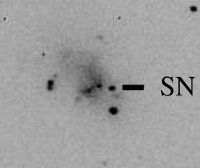The mysterious too-dim supernova discovered by a 14-year-old

Supernova SN 2008ha is a particularly interesting supernova, for two reasons. First, because it was discovered by a 14-year old New York student. I would be very interested to know more about how Caroline Moore discovered this supernova. Was she working with a school project? With a professional astronomer’s “crowd sourced astronomy” project? What data did she use? Did she do it herself in her backyard with an amateur telescope and a CCD? Inquiring minds want to know, and if somebody has more information about this, please post a link!
The other thing that’s interesting about this supernova is just how dim it is. In America, of course, it’s strange to say that. We’re always interested in the biggest and baddest. The most distant! The brightest! The most energetic! The most luminous! But, just like “intermediate mass black holes”, this supernova seems to fall into a gap that makes it difficult to understand exactly what it is. Not that there aren’t things that it could be— but the problem is, if anything, there are too many things it could be!
 The press release I link to above describes it as bridging the gap between novae and supernovae, but that may not really be an accurate description. Both novae and thermonuclear supernovae (but not core-collapse supernovae) come from a similar progenitor system. A white dwarf star— a star 1.4 times the mass of the Sun, but only the size of the Earth— pulls matter off of a companion star, probably a red giant. The matter builds up on the white dwarf, until one of two things happen. In a nova, the outer layers of the star get dense enough to trigger nuclear fusion in just those outer layers. An explosion ensues, and we can see it as a nova. The same binary system can produce a nova more than once. In a supernova, the white dwarf star reaches a critical mass known as the Chandrasaekar mass, and the entire 1.4 solar masses of star blows itself away in a tremendous thermonuclear explosion.
The press release I link to above describes it as bridging the gap between novae and supernovae, but that may not really be an accurate description. Both novae and thermonuclear supernovae (but not core-collapse supernovae) come from a similar progenitor system. A white dwarf star— a star 1.4 times the mass of the Sun, but only the size of the Earth— pulls matter off of a companion star, probably a red giant. The matter builds up on the white dwarf, until one of two things happen. In a nova, the outer layers of the star get dense enough to trigger nuclear fusion in just those outer layers. An explosion ensues, and we can see it as a nova. The same binary system can produce a nova more than once. In a supernova, the white dwarf star reaches a critical mass known as the Chandrasaekar mass, and the entire 1.4 solar masses of star blows itself away in a tremendous thermonuclear explosion.
Thermonuclear supernovae are important not just because of what they represent in the potential life cycle of a star, but also because every time they explode, they release about the same amount of energy— The Chandrasaekar Mass is pretty much the same for every star. This has allowed them to be used as “standard candles” in measuring the expansion rate of the Universe, and it was observations of these objects that led us to the discovery that the expansion of the Universe is accelerating.
SN 2008ha was roughly 100 times dimmer than a typical thermonuclear supernova. This wasn’t because it was behind dust; the velocities measured in the expanding gasses were also much lower than is typically observed in a supernova. However, it’s much too luminous to be a mere nova. So what is it? The possibility suggested by the press release is that it really is something between a nova and a supernova: more than the outer layers of the star exploded, but it wasn’t the massive explosion of the entire star. However, if you look at the submitted paper describing follow-up observations of this event, we’re not really sure just what it was. The paper seems to be leaning towards it probably coming from a white, but it’s uncertain as to whether the explosion mechanism was core-collapse or thermonuclear. If the mechanism was core-collapse, then this is much like a very low-luminosity version of a traditional core-collapse supernova that signifies the end of the line for a massive star. In this case, it would be a star that was just barely massive enough to go supernova, and indeed, the supernova might have happened after the star shed its outer layers and left behind a white dwarf. No doubt that further work— observational on this event, and hopefully on more discoveries like this one, as well as theoretical— will be necessary to have a better idea of what really happened.
These events are probably quite rare, indeed probably rarer than normal thermonuclear supernovae (which happen, very roughly, about once per 500 years per galaxy). However, the fact that we only know of one right now shouldn’t be interpreted to mean that it’s a singular event. Thermonuclear supernovae are rare, but they’re bright, so we can see them in distant galaxies, and we’ve developed techniques to find them in great numbers. These dimmer events will be much harder to find.
It’s always exciting when something new, or at least something that shows a new wrinkle, is found in nature.

June 13th, 2009 at 11:51 am
More than you ever wanted to know.
http://deer-pond-observatorie.wetpaint.com/page/The+story+about+SN2008ha
June 16th, 2009 at 3:38 pm
You asked for a link about Caroline’s story so here it is.
Caroline will be on The Rachel Maddow Show on Friday the 19th the TV show airs Friday at 9 p.m. Eastern on MSNBC-TV, and is re-broadcast on MSNBC at 11 p.m. and 2 a.m.and Fox News channel some time Wed the 17th between 1:00 pm and 3:00pm.
Please note; breaking news drives the the networks and Caroline could be bumped if NBC and or Fox News are working a big news story.
http://deer-pond-observatorie.wetpaint.com/page/The+story+about+SN2008ha